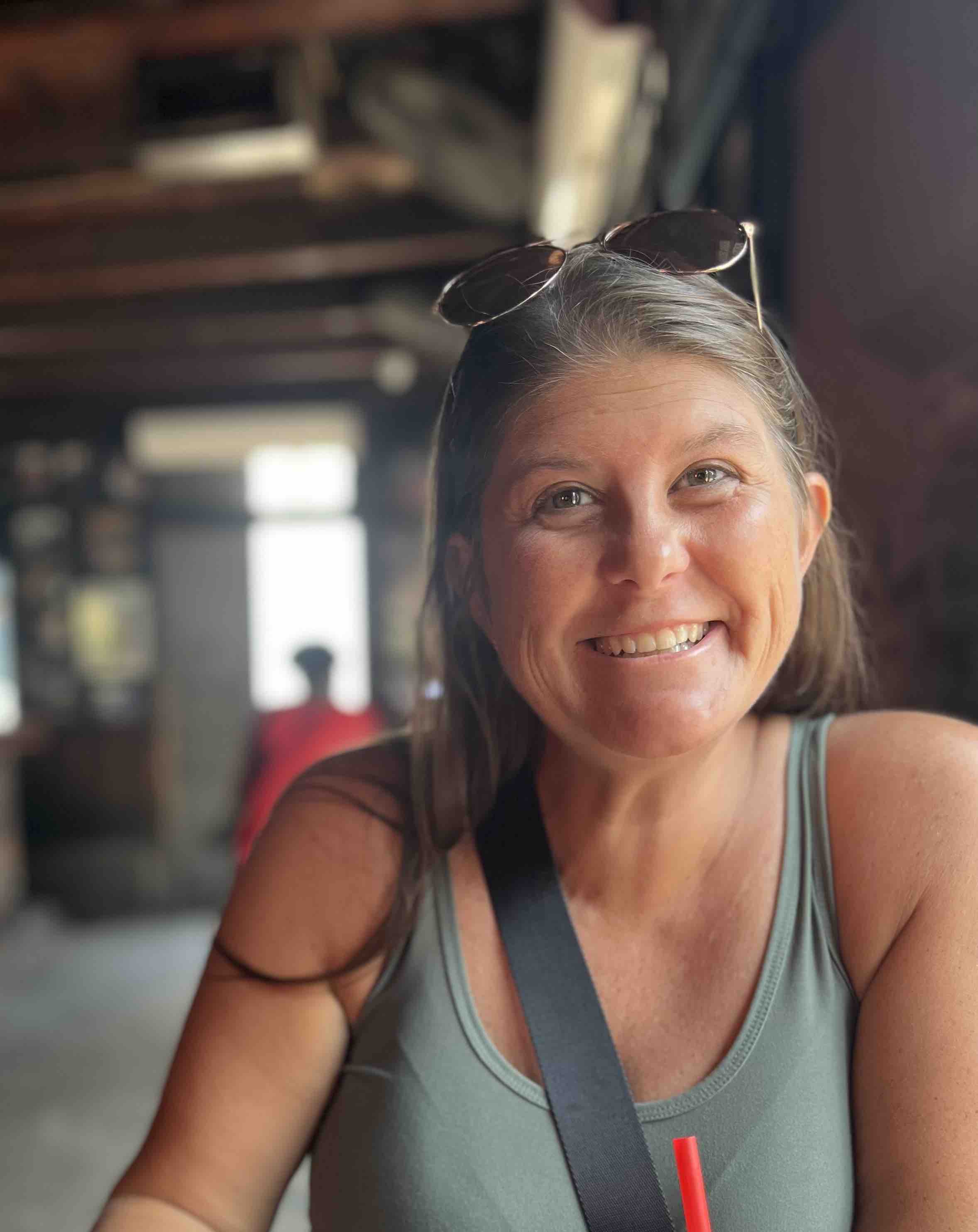
Saw the Marginalized: What DID Jesus DO?

We arrived at the graduation an hour early, not because I wanted to sit in the bleachers for an extra hour, but because I simply wanted a seat–even if it was in the bleachers.
Kate had given us very specific instructions about where we should sit based on where she would be sitting with her graduating class. For best picture access, we needed to situate ourselves around the fourth row back on the visiting side of the gymnasium. When the doors opened, we made our way to this very specific section and quickly found seats toward the bottom of the bleachers.
Then, we proceeded to sit in the very uncomfortable bleachers for an hour as the gym filled with the families and friends of the graduates. Quickly, all of the seats in the gym filled up and people began standing in the areas in the back of the gym as well. Amid the people watching, I browsed the graduation program and noticed a variety of speakers. I immediately had two thoughts–1. This is going to take forever and 2. At least there will be some variety in what we have to, I mean get to, listen to.
Finally, the band began to play Pomp and Circumstance and the graduates filed in, took their ceremonious lap around the gym, and found their seats. After the standard welcome and playing of the Star Spangled Banner, we settled back into our seats for the duration.
The class president spoke briefly about the accomplishments of the class.
Then, the principal spoke briefly…about the same accomplishments of the class…
Then, the vice president spoke…about the same accomplishments of the class…
And on it went.
I was in the second row of the bleachers. The graduates were just a few feet in front of me, and I saw it as soon as it started to happen. The graduates were getting restless. Sitting for 30 minutes listening to multiple speakers praise the same things, the same students, and the same accomplishments was redundant and unrelated to 90% of the graduates sitting in those seats.
The longer it went on, the more irritated I became. I was watching as more and more graduates started nodding off, pulling out their phones, and fidgeting in their seats.
This wasn’t a ceremony for this graduating class as a whole; this was a ceremony for the 10% of students who were class officers, band members, and athletes. There was nothing for everyone else, and there was definitely nothing for the graduates on the fringes–the ones in the margins.
They might as well have been invisible or absent entirely because they didn’t fit in the box these leaders and speakers labeled “successful,” “accomplished,” or “worthy of mentioning.”
I’d love to say this was a singular instance, but, sadly, so many of us are guilty of overlooking or not even seeing those on the fringes and in the margins.
The Marginalized were Seen and Heard by Christ
You might be familiar with the story in Luke 8 of Jesus casting the legion/mob of demons into the herd of pigs. You can find the whole story in Luke 8:26-39. This story takes place right after Jesus and His disciples were crossing the lake and the storm kicked up. You can read more about the story in last week’s blog. As soon as the group landed on shore, they were confronted by a demon-possessed madman (Luke 8:28 TPT). This is how Luke described this guy:
Many times he had been put under guard and bound with chains, but the many demons inside him had repeatedly thrown him into convulsions, breaking his shackles and driving him out of the town into the countryside. He had been demonized for a long time and was living naked in a cemetery among the tombs.
Luke 8:27-28 TPT
This poor guy had been possessed by a legion of demons for a long time. The townspeople tried to restrain him with no luck. Consequently, the demons forced this guy out of town into the countryside where he was living–naked. Maybe this is where the concept of Naked and Afraid came from. Who knows?
These details provide an interesting twist to this story. This man was naked and living in a cemetery–unable to be restrained, and yet, he’s the one who is there to meet Jesus as soon as He lands on shore.
They had a brief conversation where Jesus learned there was a legion of demons possessing this man, but before Jesus spoke the word and drove out the demons, they asked him not to torture them and not to cast them into the Abyss. Then, they begged to be cast into a herd of pigs estimated to number around 2000.
I read quite a few discussions on this scene. They were…interesting to say the least.
To be completely honest with you, I don’t have a solid explanation of why Jesus cast the demons into the pigs. I don’t know for sure why the pigs hurled themselves into the sea, and I don’t know if Jesus was trying to teach the pig farmers a lesson or not.
What I do know is this: there was a man living in the extreme margins of his society who sought out Christ and was both seen and heard by the Savior.
A man.
A human.
A person.
Not just a character in a story.
Not just a figure to be used in illustrations.
A living, breathing human man.
I needed a minute to let this sink in.
For years in the different churches I’ve been in, we’ve talked about Jesus, the demons, and the pigs. They seem to get the spotlight in this story, don’t they? But, what about this poor, naked, suffering man, who was essentially an exile of his community?
In a way, we tend to keep him out there in the margins of this story, but moving him to the center shifts the focus of this narrative a bit.
What if we took a few minutes to think about his life and his plight?
The Result of Truly Seeing and Hearing People
What happens next in this story is pretty cool. It’s one of my favorite parts, honestly. The pig farmers get a little miffed because their entire herd just died–understandably so, really, but this isn’t the cool part. The cool part is what happens with the guy:
When they came to where Jesus was, they discovered the notorious madman totally set free. He was clothed, speaking intelligently, and sitting at the feet of Jesus. They were shocked!
Luke 8:35
I don’t know how long this guy had been living with all these demons possessing him, but I do know after he was set free, he chose to stay and sit at the feet of Jesus.
Jesus saw him.
Jesus heard him.
Jesus set him free.
The result: a desire to be closer to Jesus.
The rest of the townspeople weren’t quite as keen on the events of the day and couldn’t get rid of Jesus fast enough. When Jesus was leaving, though, this freed man “begged Jesus over and over not to leave, saying, ‘Let me be with you!’” Luke 8:38 TPT.
This man who had been separated from his friends, family, loved ones, and his entire community for years chose following Christ over them.
Jesus encouraged him to foster the relationships he’d lost, though, telling him:
“Return to your home and your family, and tell them all the wonderful things God has done for you.” So the man went back and preached to everyone who would listen about the amazing miracle Jesus had worked in his life.
Luke 8:39 TPT
Just like that, Jesus moved this man from the margins of his society back into the center.
The Challenge of the Margins
You might be sitting there thinking, “Yes, but we don’t have naked, demon-possessed men living out back in our cemeteries,” and you’d probably be right.
We do have margins and fringes of our societies, though, and there are most definitely people living in them who no one bothers to see or hear.
I’m sure right now as you read this, someone or maybe a group of people who only ever really occupy space in your periphery has popped into your mind.
What can we do for them?
How can we be so loving and so accepting of them that they are expectantly waiting to meet Jesus?
Or, better yet, how can we be so much like Jesus, we rescue them from whatever is holding them back, possessing them, or pushing them to the margins and the fringes to begin with?
I hope this gives you pause today, friend.
I heard a saying not too long ago. It’s both irked me and stuck with me:
“Grace for me, but not for thee.”
Have you heard it before?
Have you thought about it before?
Are you guilty of thinking this way?
Subconsciously, do you believe God’s grace is enough for you, but it isn’t enough for:
The addict
The felon
The homeless
The adulterer
The white-collar criminal
The depressed
The liar
The thief
The murderer
I could go on, but I think you get the idea.
In too many of our minds and in too many of our churches and faith communities, this is the undercurrent–grace for me but not for thee.
And this has to change, friends.
This was not the mindset of Christ on earth, and it is the furthest thing from what our mindsets should be in our faith communities and as Christ's followers. We should be running out to the margins and the fringes and genuinely wanting to love the folks we find there.
Jesus didn’t just see and hear these marginalized folks; he touched them, healed them, rescued them, saved them, and then sent them on their way in the ministry.
Grace for me and most definitely for thee–I like this saying a whole lot better.
Friend, this is a tough one. This is one so hard to put into practice, but it’s also one that is so very important.
I pray you see the people on the fringes and in the margins this week and God nudges you to bring them to the center of your narrative.

Reflections:
Who are the people in your world who are living on the fringes or in the margins of your society?
How do you respond and react when you’re confronted with them?
When you take a deep dive into your subconscious, how do you feel about “Grace for me but not for thee?”
